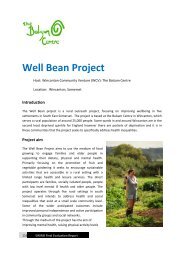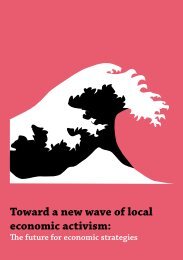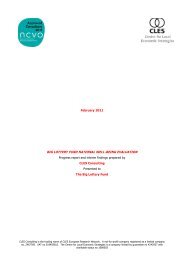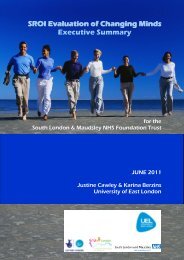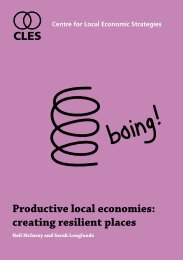Research Methods Handbook.pdf - CLES
Research Methods Handbook.pdf - CLES
Research Methods Handbook.pdf - CLES
Create successful ePaper yourself
Turn your PDF publications into a flip-book with our unique Google optimized e-Paper software.
ObservationWhat is observation?Observation, sometimes referred to as “participant observation” or“ethnography” is the key method of anthropology and in itself canconsist of a mix of techniques; informal interviews, direct observation,participation in the life of the group, collective discussions, analyses ofpersonal documents produced within the group, self-analysis, and lifehistories,notes, diaries and transcripts are often kept and the observationmethod can generate a lot of written material which the investigatormust synthesize.Participant observation is usually undertaken over an extended periodof time, ranging from several months to many years. An extendedresearch time period means that the researcher will be able to obtainmore detailed and accurate information about the people he/she isstudying.When should it be used?Observation is more appropriate when seeking to uncover:Observable detailsLike daily time allotment. For example, the popular managementconsultancy technique of the “time and motion study” is a version ofobservation. The investigator watches the activities and actions ofpeople involved in a process and works out the specific time allocationdevoted to every single step, with the objective of improving efficiencyby cutting out unnecessary or time consuming steps.Group dynamicsIf the subject of your enquiry is a collective, in this context more likelyto be a partnership board or steering group rather than a tribe orsub-culture, then close attention to the dynamics of the interactionbetween the people involved can be very illuminating. The observationmethod highlights interpersonal relationships and the investigator canreflect upon social proximity and distance, observe relationships andexplore body lanuage and other behaviours.More hidden detailsLike taboo behaviour. Observation can be effective in exploring orexposing secrets or the underlying realities of situations, researcherscan discover discrepancies between what participants say – and oftenbelieve – should happen (the formal system) and what actually doeshappen, or between different aspects of the formal system; in contrast,a one-time survey of people’s answers to a set of questions might bequite consistent, but is less likely to show conflicts between differentaspects of the social system or between conscious representations andbehavior.What do I need to consider?Observation as part of a mixed methods approachObservation may be appropriate as a part of your research strategy butit is unlikely that it would “stand alone” in the research contexts thatwe have been describing. It is also worth remembering that it reliesvery heavily upon the judgements, assumptions and prior knowledgeand experience of the observer themselves.Reliability vs ValidityParticipant observation (whether overt or covert) is not the most reliableresearch method. Such studies, by their very nature, are impossibleto repeat and reliability can be further questioned in terms ofthe extent to which the presence of the observer actually changes thebehaviour of those being studied. As soon as you do or say anythingat all, you have slipped from the role of observer to participant, thisboundary can be very hard to maintain.Participant observers study people in their natural environment, gaininga depth of insight into behaviour that comes not simply from close,detailed, observation but also from the researcher’s own experienceswithin the group being studied – a technique that provides first handinsights into why people behave as they do. Participant observationdoes not prejudge issues and events (in the way a questionnaire may,for example) and, for these reasons it is possible to argue that such amethod provides data that has a high level of validity.Skills requiredParticipant observation requires a great deal of skill and commitmentfrom the researcher. The success or failure of the research will hinge50 51



